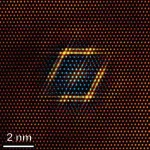(Press-News.org) Atrial fibrillation (AF) is a common form of heart arrhythmia, a serious condition in which the heart beats so fast that its upper chambers, the atria, quiver. This irregular heartbeat can increase the risk of severe conditions, including heart failure, dementia and stroke.
“My lab has been studying the role of inflammation in the initiation and persistence of AF for many years. In this multidisciplinary study, we investigated the function of gasdermin D, a key participant in inflammatory pathways, in atrial heart cells and its potential contribution to AF,” said corresponding author Dr. Na Li, professor of medicine at Baylor College of Medicine.
The work is published in the European Heart Journal.
Previous studies have shown that in immune cells, gasdermin D is cut into two fragments; NT-gasdermin D, which can trigger cell death in immune cells, and CT-gasdermin D, whose function is unknown. “Although prior studies suggest that gasdermin D activation could contribute to a heart attack by causing cell death, the precise function of gasdermin D in heart cells remains poorly understood,” Li said.
The researchers studied sections of human atria to assess the levels of gasdermin D and found increased levels of the protein in AF patients. The team also worked with a mouse model in which they increased the levels of NT-gasdermin D only in atrial heart cells. “These mice had an increased susceptibility to AF,” Li said.
Further studies showed that NT-gasdermin D does not kill most of the heart cells but mediates the formation of pores in the cell membrane. The pores facilitate the release of heart cell-produced cytokines, immune mediators that promote the infiltration of immune cells to the atria, which can initiate events leading to atrial dysfunction. Interestingly, at the same time the cells enhanced membrane-repair mechanisms, which acted as a countermeasure to pore formation and prevented atrial cell death.
“Additionally, NT-gasdermin D directly targeted mitochondria, the cell’s main source of energy, mediating pore formation and increasing the release of mitochondrial reactive oxygen species (ROS),” said first author Dr. Yue Yuan, a postdoctoral associate in the Li lab. “As ROS pours into the cells through the mitochondria, it triggers the abnormal release of calcium, which in turn promotes events that generate arrhythmias.”
Supporting these findings, the team found that mitochondria-specific antioxidant MitoTEMPO, which scavenges ROS, mitigated arrhythmias induced by NT-gasdermin D. A mutant NT-gasdermin D lacking the ability to form pores failed to cause mitochondrial dysfunction or induce atrial arrhythmia. And eliminating the gene for gasdermin D also prevented spontaneous AF development in the animal model.
“Our study reveals that NT-gasdermin D plays a novel role in AF development through multifaceted mechanisms,” Yuan said. “Our findings support that atrial NT-gasdermin D contributes to heart arrhythmias via a unique mechanism that does not involve cell death but promotes mitochondrial dysfunction.”
“The findings suggest that mitochondrial-targeted therapy, either by reducing ROS production or inhibiting gasdermin D, may prevent triggering AF,” Li said. “This positions gasdermin D as a promising target for novel therapeutic option for AF.”
Other contributors to this work include Pascal Martsch, Xiaohui Chen, Enrique Martinez, Luge Li, Jia Song, Theresa Poppenborg, Florian Bruns, Jong Hwan Kim, Markus Kamler, James F. Martin, Issam Abu-Taha and Dobromir Dobrev. The authors are affiliated with one or more of the following institutions: Baylor College of Medicine, University Duisburg-Essen, the Texas Heart Institute and the University of Montreal.
This study is supported by grants from the National Institutes of Health (R01HL164838, R01HL136389, R01HL163277, R01HL131517, R01HL089598, R01HL165704, R01HL127717, R01HL169511 and R01HL171574). Further support was provided by American Heart Association (grants 936111 and 23POST1013888), the European Union (large-scale integrative project MAESTRIA, No. 965286), and the Deutsche Forschungsgemeinschaft (Research Training Group 2989, project 517043330).
###
END
Gasdermin D emerges as a potential therapeutic target for atrial fibrillation
2025-03-27
ELSE PRESS RELEASES FROM THIS DATE:
Mapping the Earth’s crops
2025-03-27
As agricultural research continues to become more entwined with technology, smart farming – a phrase that encompasses research computing tools that help farmers to better address issues like crop disease, drought and sustainability – has quickly become a ubiquitous term in Ag labs across the country. The availability of NCSA resources like Delta for researchers, both nationally and on the University of Illinois Urbana-Champaign (U. of I.) campus, has fostered a hotbed of cutting-edge research projects in the agricultural domain.
Yi-Chia Chang, a Ph.D. student at the ...
Rideshare data reveal discriminatory policing for speeding in Florida
2025-03-27
Using data on more than 220,000 individuals on the Lyft rideshare platform, researchers report that drivers of color are significantly more likely to receive speeding tickets than white drivers, and to face steeper fines, even when traveling at identical speeds. Racial profiling by law enforcement is a pressing social issue in the United States. Previous research analyzing police and judicial records suggests that racial and ethnic minorities face disproportionately higher rates of searches, fines, force, detentions, and incarceration compared to white civilians. However, research on racial bias in policing has long been hindered by data limitations ...
Unique genetic mutation underlies horses’ exceptional athleticism
2025-03-27
Researchers have revealed a secret behind horses' exceptional endurance – a mutation in the KEAP1 gene that boosts energy production while protecting against cellular oxidative stress. The findings – which shed light on a unique evolutionary adaptation that has shaped one of nature’s most powerful athletes – hold potential implications for human medicine. They also highlight how the recoding of a de novo stop codon – a strategy thought restricted to viruses – can facilitate adaptation in vertebrates. Long prized for their speed and endurance, horses possess remarkable physiological adaptations ...
Dopamine-producing brain circuit drives eating “for pleasure” in mice
2025-03-27
A previously overlooked dopamine-producing brain circuit drives hedonic eating, or eating for pleasure, according to a new study in mice. The findings offer insights into how GLP-1 agonist drugs like semaglutide affect appetite suppression and why pleasing and delicious foods can override these drugs’ effects. In a related Perspective, Dana Small argues that the findings indicate that the inter-individual differences in the adaptation of this circuit in response to GLP-1 drugs may account for differences in treatment efficacy in humans. “Future work that aims to minimize such adaptation could offer a promising avenue for the development of ...
Balancing national priorities and basic research in China
2025-03-27
As China rises as a global science power, its government has increased efforts to align basic research with national priorities, such as economic growth, environmental sustainability, and national security. In a Policy Forum, Andrew Kennedy discusses how this increasing emphasis on national priorities creates tension with basic research in China – a pattern that reflects broader global trends – and the potential risks of prioritizing near-term objectives over long-term scientific discovery. According to the author, neglecting curiosity-driven research while expanding support for near-term priorities is short-sighted. Without it, transformative innovations – from ...
Feeling the future: New wearable device mimics the complexity of human touch
2025-03-27
When it comes to haptic feedback, most technologies are limited to simple vibrations. But our skin is loaded with tiny sensors that detect pressure, vibration, stretching and more.
Now, Northwestern University engineers have unveiled a new technology that creates precise movements to mimic these complex sensations.
The study will be published on March 28 in the journal Science.
While sitting on the skin, the compact, lightweight, wireless device applies force in any direction to generate a variety of sensations, including ...
New discovery boosts wheat's fight against devastating disease
2025-03-27
A new study published in Science by a team of scientists across five continents led by King Abdullah University of Science and Technology (KAUST) Associate Professor Brande Wulff reports a previously unknown molecular event that initiates the immune response to a major wheat disease. The findings provide strategies to engineer wheat that has stronger immunity against infection.
As the main food staple for billions of people and one of the main sources of animal feed, wheat is one of the most important food commodities in the world. This importance is why a wheat pandemic can be even more devasting than a human pandemic.
"Climate change ...
Testing patients for just three genes could help prevent three quarters of avoidable side effects of certain medications
2025-03-27
UNDER STRICT EMBARGO UNTIL THURSDAY 27 MARCH 2025 AT 11 AM PACIFIC TIME / 2 PM EASTERN TIME .
Peer reviewed | Observational study | People
A new study from Queen Mary University of London found that 9% of all reported adverse drug reactions (ADRs) reported to the UK medicines regulator are associated with medications where side effect risk is partly dependent on patient’s genes. Of this subset of ADRs, 75% were associated with only three genes that impact how the body processes medication. Genetic testing before prescribing ...
A genetic tree as a movie: Moving beyond the still portrait of ancestry
2025-03-27
ANN ARBOR—University of Michigan researchers have developed a statistical method that can be used for such wide-ranging applications as tracing your ancestry, modeling disease spread and studying how animals spread through geographic regions.
One of the method's applications is to give a more complete sense of human ancestry, says Gideon Bradburd, U-M professor of ecology and evolutionary biology. For example, when you send your DNA off for a personalized ancestry report, the report you get back is only a very small view of your family tree pinned in a specific point ...
New material gives copper superalloy-like strength
2025-03-27
Researchers from the U.S. Army Research Laboratory (ARL) and Lehigh University have developed a groundbreaking nanostructured copper alloy that could redefine high-temperature materials for aerospace, defense and industrial applications.
Their findings, published in the journal Science, introduce a Cu-Ta-Li (Copper-Tantalum-Lithium) alloy with exceptional thermal stability and mechanical strength, making it one of the most resilient copper-based materials ever created.
“This is cutting-edge science, developing a new material ...


